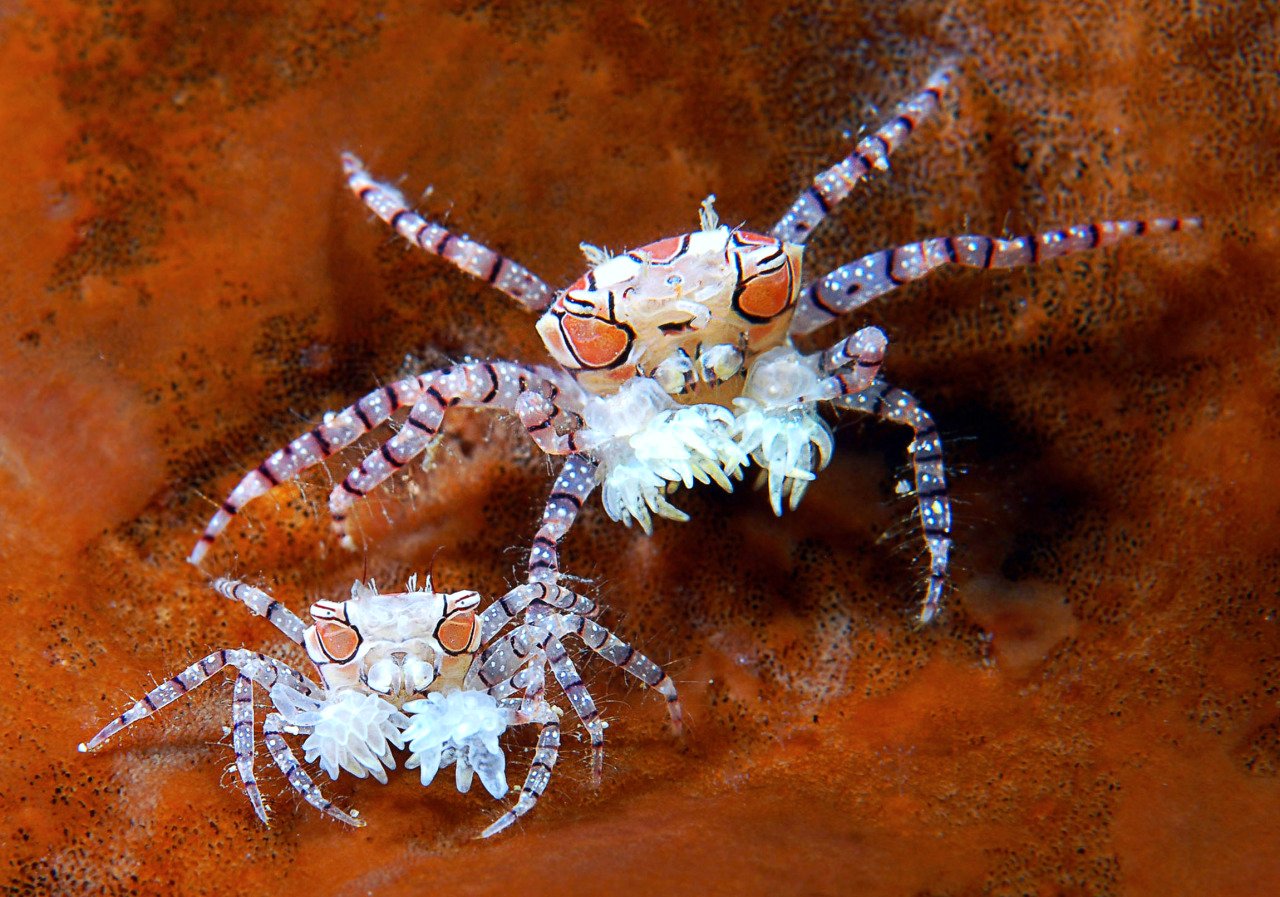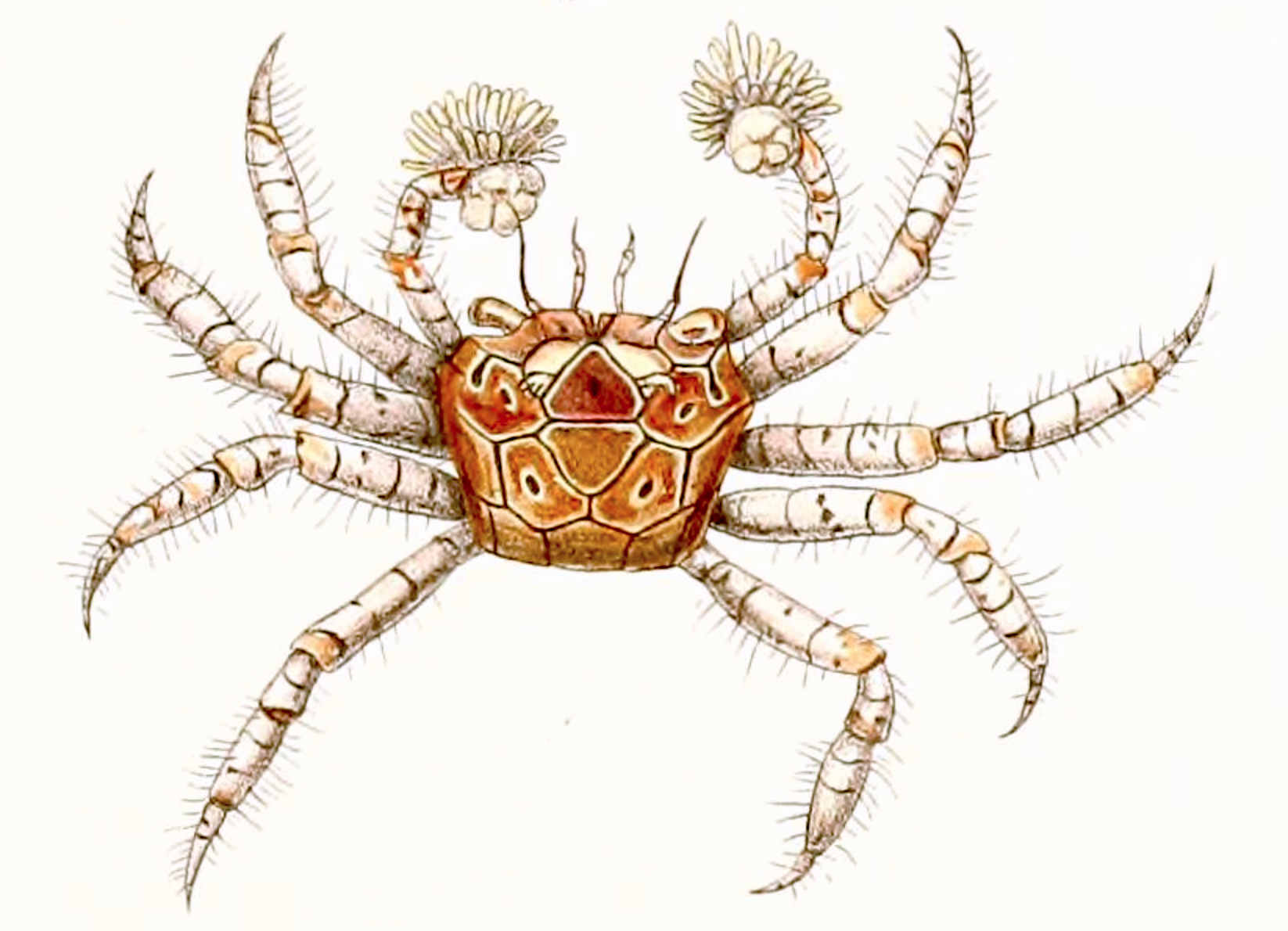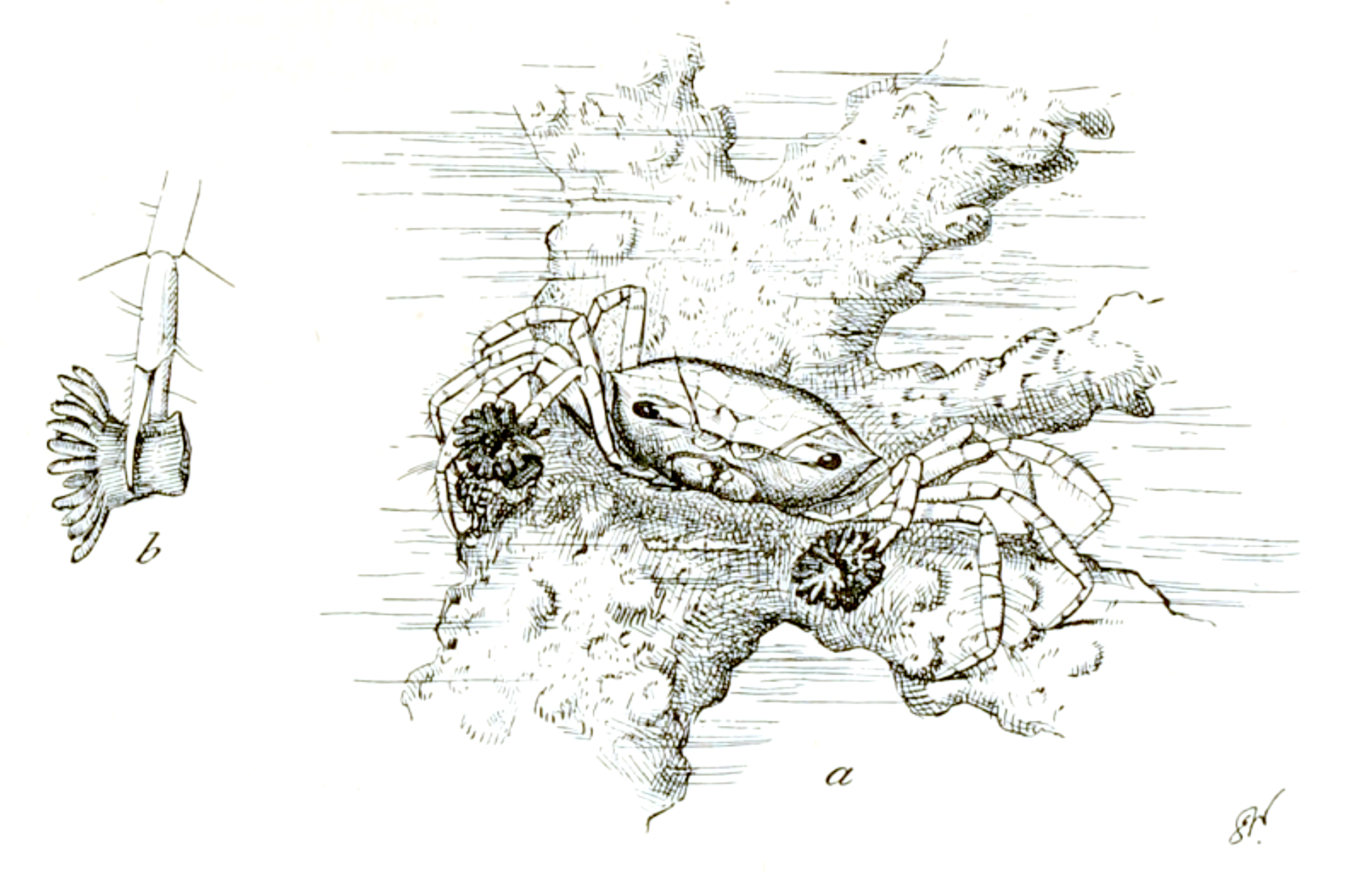1874 | Île aux Fouquets, Mauritius
Boxer crab (Lybia tessellata) anemone wielding
A recurring theme for this blog is the way that tool-using animals gradually emerge into the consciousness of the scientific world. One path goes something like this: (i) a wild animal’s tool use behaviour is well known to the local people who have lived around the animal for generations, before (ii) western naturalists and collectors show up in the 19th and 20th centuries and publish their initial ‘discoveries’, often excluding the locals, and then (iii) those initial reports get ignored by the scientific community for decades before being reaffirmed through new work.
Today’s case-study in point: the boxer or pom-pom crab. We’ll see how this small crab drifted in and out of scientific study over two centuries, and how its highly unusual exploitation of other animals as food-gathering tools brings a brutal new meaning to ‘tear-and-share’.
Möbius tip
By the time Karl Möbius drew a tiny, coral-dwelling, speckled crab he found in the waters around Île aux Fouquets, Mauritius, he was headed to the top of the German zoological world. It was September 1874, eleven years after Möbius founded Germany’s first sea-water aquarium in Hamburg. He was still more than a decade from becoming head of zoology at Berlin’s Natural History Museum, but with early encouragement from Alexander von Humboldt he had already established himself as a leader in the newly emerging field of ecology.
What caught Möbius’ attention that late September day wasn’t just the crab, though. The tiny crustacean, then known as Melia tessellata and now Lybia tessellata, was clutching a small, soft object in each of its front claws. Here’s his beautiful drawing of this inch-wide crustacean, published in 1880:
Comparing it to the modern photo of the same species at the top of this post, Möbius obviously had a very good eye for detail. Both he and his crab collaborator, Ferdinand Richters, noted that the grasped objects weren’t unique to that one specimen either. Every crab they found of this species seemed to be carrying the same burden: a sea anemone in each claw
And Melia/Lybia wasn’t alone. From the same island, the scientists collected specimens of the closely related Polydectus cupulifer that also grasped some squishy companions. Going back through previous descriptions, Richters found that this relationship between crab and anemone was a long-standing one, even if it wasn’t always explicitly recognised. For example, in 1825 entomologist Pierre André Latreille wrote of a small crab he knew then as Pilumnus cupulifer, which had ‘une substance peut-etre gommeuse et glutiante, formant un empätement ä l'extremite’ [a gummy and sticky substance at the end of the claws]. The crab itself doesn’t make such a substance, so the logical explanation is that the dead crab Latrielle examined still clutched parts of its sea anemone tools. And an 1837 illustration in Georges Cuvier’s Le Règne Animal shows a Pilumnus cupulifera with something odd and anemone-like in its left claw, unmentioned at the time:
Not that collecting comparative specimens—alive or dead—was particularly easy in those days. For instance, two Polydectus cupulifer gathered by James Dana in the Pacific were lost when the ship carrying them to the US ran aground and sank at the mouth of the Columbia River in 1841. That ship, the Peacock, was actually the first one to be commissioned for the US Navy’s scientific exploration of the Pacific, and a large number of collected items were lost along with the ship. The ship’s artist, Alfred Agate, caught its final moments as the crew abandoned it—you’ll need to imagine two tiny crabs going down with the vessel, which has lost its three masts but not its proud US flag:
A weapon or implement
More decades passed, and it wasn’t until the twentieth century dawned that new attention to these crabs showed that they weren’t just accidentally getting sticky feet. In 1902, Cambridge University researcher Lancelot Borradaile specifically pointed out that the anemone-holding seemed to be tool use, just as we see in more familiar mammals:
we seem to have here an interesting example of the use of an implement by an animal which, however intelligent, has at least a very differently organised nervous system from the Vertebrata…the Melia carries the anemone in its cheliped—the chief grasping organ of the animal, corresponding to the hand of a primate or the trunk of an elephant—and, whatever its use, it cannot be a means of passive concealment, to which its size is wholly inadequate.
Borradaille, who also came up with the term ‘carcinisation’ to refer to the fact that life has over and over again made animals that look like crabs, rightly dismissed the held sea anemones as a possible form of disguise. Other crabs do place anemones on their shell as a kind of camouflage, but the little anemones don’t do that job. Exactly what job they did for the crab wasn’t clear, although Borradaille surmised that ‘the actinians, which are grasped firmly round the middle below the tentacles, may be useful, by means of their stinging-cells, either for defence or to "fish" for food with, or perhaps for both purposes’.
A few years later in 1905 James Duerden, another Englishman, made the first detailed study of the relationship between live crabs and their animal companions. Duerden had been a curator in the Institute of Jamaica in Kingston, and so had first hand experience with the tropical waters in which these crabs lived. During a coral-collecting trip to Hawaii he found and collected two live Lybia tassellata individuals, with which he could then experiment.
Both of the L. tessellata crabs held sea anenomes—or actinians—although one clasped anemones of the genus Bunodeopsis, while the other held Sagartia. Immediately Duerden could therefore rule out a one-to-one symbiotic relationship between crab and a given anemone species. An experiment confirmed this interchangeability: when the crab that originally held the Bunodeopsis anemones had them taken away, and the Sagartia ones placed in its tank instead, after a bit of wandering around the crab found and immediately grabbed the new tools. If the anemone was firmly attached by its base to the tank, as they are to rocks and corals in nature, the crab would hold it around the middle and use its other legs to prise the actinian loose.
Duerden also found that the crabs readily picked up any combination of the two anemones, and would even discard a damaged anemone for a whole one, a process that he wrote ‘must unquestionably be described as intelligent selection’. In a prescient note, Duerden also saw that
there appeared to be evidence that the crab will tear a single actinian in two in order to provide each claw with a polyp.
The anemones were typically held with their tentacles facing upwards or away from the crab, in what could be either a defensive or threatening attitude. If the crab thrusts its claws towards an encroaching predator, the stinging tentacles lead the way, and we get the ‘boxer’ part of the animal’s common name, as in this video of a Lybia crab from PBS Nature:
The defensive aspect of the anenomes may be reason enough for these crabs to have routinely collected and carried them. But is it sufficiently useful to give up the use of those two front claws, which otherwise would be the main way that the crab would gather food? As Duerden found, the crabs have that covered too, in a kind of one-two punch by the crafty crustaceans.
The anenomes normally gather their own food by pulling it in with their tentacles as it drifts past on the current. The crabs shamelessly hijack that behaviour for their own ends. By placing bits of food near the crab, experiments showed that any food large enough to catch the crab’s attention, likely through chemical detection, is snatched away from the anemone as the little actinian pulls it towards its own mouth. Tiny pieces escape the crab’s notice, so the anemone doesn’t completely starve, but Duerden’s semi-anthropomorphic comparison is apt:
In the language applied to human actions, it can truly be said that the crab robs the actinian of its food, though no one would think of introducing ethical considerations into the act, even if consciousness could be established.
Ultimately, the conclusion was that the anemones can get by just fine without a crab lugging them around, but the same could not be said in reverse. Without their little stringy tools, the crabs are left with rather ineffective grasping claws. And the fact that wild crabs are rarely found without clasped anemones, and quickly pick up ones if deprived of them, suggests a strong reliance by the larger on the smaller animal. This is perhaps the earliest known instance of one animal habitually using another as a tool in the wild, which did not escape Duerden:
The fact of one animal making direct use of an altogether different type of animal whereby to obtain its food, employing it as if it were a weapon or implement, would appear to be unique among the lower animals.
Split decision
All of which brings us to the final phase of the tool-use discovery sequence. You might think that reports of extraordinary tool-using crabs would have set in train a dedicated research effort throughout the 20th century, prompting all sorts of experiments to discern the relationship and trade-offs faced by crab and anemone alike, and playing into wider discussions about animal intelligence and creativity. Instead, crab tool use studies entered something of a century-long dark age, emerging again into the light only in experiments begun in 2007 by Israeli scientist Yisrael Schnytzer.
Schnytzer works with boxer crabs of the species Lybia leptochelis, which lives in the Gulf of Eilat. It tends to carry actinians of the genus Alicia, holding and wielding them just as the Pacific examples we’ve been discussing hold their own living tools. Schnytzer’s team began by putting another sword through the idea that the crab-anemone relationship is somehow equally beneficial to both parties. They showed that not only do the crabs steal food from the anemones, but this theft severely stunts the latter’s growth. When held by a crab, the anemone is kept to a manageable size, essentially through food deprivation. Allowed to live freely, the Alicia individuals more than triple in size. Just look at the extraordinary difference between the two anemones held in crab captivity beside a free-living Alicia specimen (the scale bar is 2mm):
The crabs are not only stealing food, they’re controlling the growth of their captive tools/companions, creating ‘bonsai anemones’ in Schnytzer’s words. There’s a scientific term for the crab’s behaviour: kleptoparasitism. The crab is essentially a parasite on the anemone, despite being the larger of the two animals involved.
And the exploitation doesn’t stop there. Remember back in 1905, when James Duerden noted that a crab would sometimes tear one of its captives in two? Anemones can recover from that kind of ill-treatment in a way that we humans (or the crabs for that matter) do not, by regrowing a healthy animal from the pieces left behind. Schnytzer followed up on this observation with the first detailed study of that tearing behaviour.
He and his colleagues found that anemone splitting seemed to be a common way that a Lybia crab gets from one to two tools. In their experiments, 77% of the time they tool away one of a crab’s anemones, the crab tore the remaining one in half and allowed both to regrow to the same size as the original. Genetic study of wild-collected crabs backed this finding up: in each case the two Alicia anemones held by a single crab were genetically identical, meaning that they had originally been the one animal.
From an effort perspective this makes sense: why waste time searching for a second tool if the first one you find will literally grow a new one for you? And you might not even have to find that first free-living anemone, if you chance upon a member of your own crab species already be-decked with some tentacled technology. Schnytzer and his team put crabs with no anemones in a tank with ones that had two, and watched as crab-fights ensued. All the empty-clawed crab needed to do was get one of the anemones from its rival, or even a decent piece of an anemone, and it could grow the rest.
In the dry language and detail of a scientific report, here’s how Schnytzer describes the tearing procedure:
Typically, the actual process of splitting lasted approximately 20 min, taking the following course: the crab held the sea anemone across the column, with the pedal disc facing upward and the oral disc and tentacles facing downward. The crab then took hold of the sea anemone with its free claw…Next, the crab slowly began stretching the sea anemone between both claws in an outward motion, utilizing its front walking legs in order to surgically tear the sea anemone in half. Occasionally, the crab momentarily ceased the stretching to re-grasp the sea anemone in what appears to be the most centered conformation possible, so that the final splitting will produce two equal parts. Once the sea anemone has been re-grasped, the crab initiated the stretching once again, slowly pulling the sea anemone from the center outwards. Once the majority of the sea anemone was split into two, there were often final strands of sea anemone tissue connecting each newly split sea anemone, which were torn by the front walking legs. Once the splitting process was complete the crab had two identical clones held in each claw.
Here’s a National Geographic video incorporating some of the team’s work, showing anemone theft and surgery in the lab:
So there you have it. Two centuries of work leading to the realisation that these crabs not only uproot anemones for their own gain, but they actively control the growth of those anemones. In the process, they can also have a significant effect on the genetics of the anemone species, by regularly producing clones through either splitting their own tools or via tool theft by other crabs.
If nothing else, the example of boxer crab tool use deserves to be much better known for its parasitic and remarkably self-sustaining aspects. Imagine if a chimpanzee could turn a single ant-dipping probe into two identical ones just by splitting it in half, or with little effort an Egyptian vulture could reliably duplicate just the right size and shape of stone it needs to crack open an ostrich egg. Boxer crabs aren’t the only animal that uses other animals as tools—consider dolphins carrying marine sponges to forage in a sandy seabed, for example—but they do seem to have taken that specialisation to a place that no other animal has reached. It may be a trope of science fiction to imagine our own machines replicating themselves, for good or ill, but for boxer crabs it’s an everyday fact of life. Until the anemone revolution, that is.
Sources: Richters, F. (1880) Decapoda. In: Mobius, K. (Ed.) Beitrage zur Meeresfauna der Insel Mauritius und der Seychellen. Berlin. || Barradiale, L.A. (1902) Marine crustaceans. III The Xanthidae and some other crabs. In: Gardiner, J.S. (Ed.) The fauna and geography of the Maldive and Laccadive archipelagoes : being the account of the work carried on and of the collections made by an expedition during the years 1899 and 1900. Vol. 1 Part 3, pp. 237-271. Cambridge, Cambridge University Press. || Latrielle, P.A. (1825) Encyclopédie méthodique. Histoire naturelle des animaux. Entomologie, ou, Histoire naturelle des crustacés, des arachnides et des insectes. Vol. 10. Paris. || Cuvier, G. (1837) Le règne animal distribué d'après son organisation, pour servir de base à l'histoire naturelle des animaux et d'introduction à l'anatomie comparée. Paris. || Dana, J.D. (1853) On the Classification and Geographical Distribution of Crustacea. Philadelphia, C. Sherman. || Duerden, J.E. (1905) On the habits and reactions of crabs bearing actinians in their claws. Proceedings of the Zoological Society of London 2:494-511. || Schnytzer, Y. et al. (2013) Bonsai anemones: Growth suppression of sea anemones by their associated kleptoparasitic boxer crab. Journal of Experimental Marine Biology and Ecology 448:265–270. || Schnytzer Y, et al. (2017) Boxer crabs induce asexual reproduction of their associated sea anemones by splitting and intraspecific theft. PeerJ 5:e2954. ||
Main image credit: Giacomo Marchione; http://www.gmphotosub.com/ || Second image credit: Richters (1880) Table XVI || Third image credit: Cuvier (1837) Crustaces Plate 14; https://www.biodiversitylibrary.org/item/88022#page/73/mode/1up || Fouth image credit: Alfred Agate, 1840; https://www.history.navy.mil/our-collections/art/exhibits/exploration-and-technology/alfred-agate-collection/1841/west-coast-of-north-america/loss-of-the-peacock.html || Fifth image credit: Borradaille (1902) || First video credit: PBS Nature; https://www.youtube.com/watch?v=BUdpqFQYeZA || Sixth image credit: Schnytzer et al. (2013) || Final video credit: National Geographic; https://www.youtube.com/watch?v=p5CyhuvFWz8





